Create Effective Email Content
Learning Objectives
After completing this unit, you’ll be able to:
- Describe how to develop a plan of action.
- Explain the considerations for designing effective content.
- Describe how to test and optimize email performance.
You know that content is worth the investment. Let’s dive in to what it means to create successful email content.
Develop a Plan of Action
To develop a good email content strategy, you need a plan of action. Start by understanding your audience and setting clear goals. With the right content strategy, you can make the most of your email messaging.
Understand Your Audience
The first step to knowing your audience is building personas. What are the day-to-day habits of your consumers? What obstacles do they face? What burning questions do they have? These questions can help you understand your audience to better target them.
A lot of that information can come from your CRM data. Use this data to understand demographics, such as age, and behavioral data, such as purchase activity. With that kind of information, you can effectively segment your audience.
Another way you can start to capture insights about your customer is to ask! A welcome email is a perfect way to ask them to complete their profile. Don’t forget to also provide an incentive, such as: exclusive discounts and the newest arrivals.
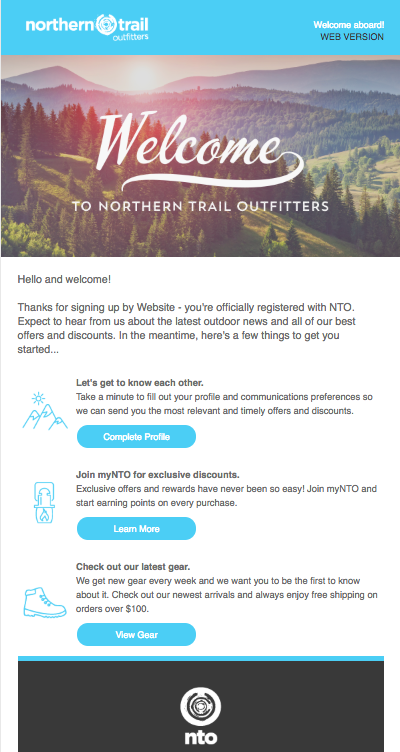
Later on, you can send a reminder to complete their profile with even more incentive, including a 20% off coupon. Notice a great gamified visual here representing that 25% of their profile has been completed.
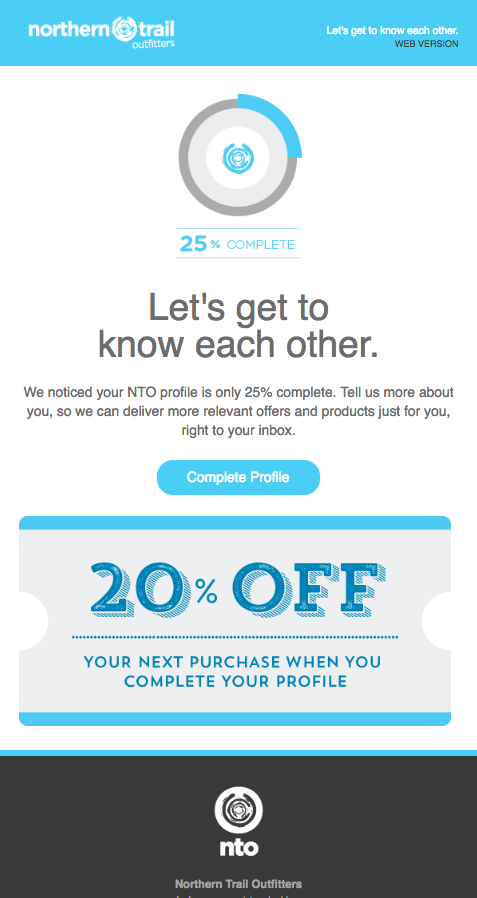
Design the Right Content
Once you understand your audience, how do you scale your program to reach these unique personas? Dynamic content will help you create one email but still deliver personalized emails to your audience. Take for example three personas for Northern Trail Outfitters—campers, yoga enthusiasts, and bikers. I can create one email but display dynamic content that changes depending on what their preference is. The content displayed is based on rules set up for each segment or persona. Each persona is represented on the left-hand side of the screenshot.
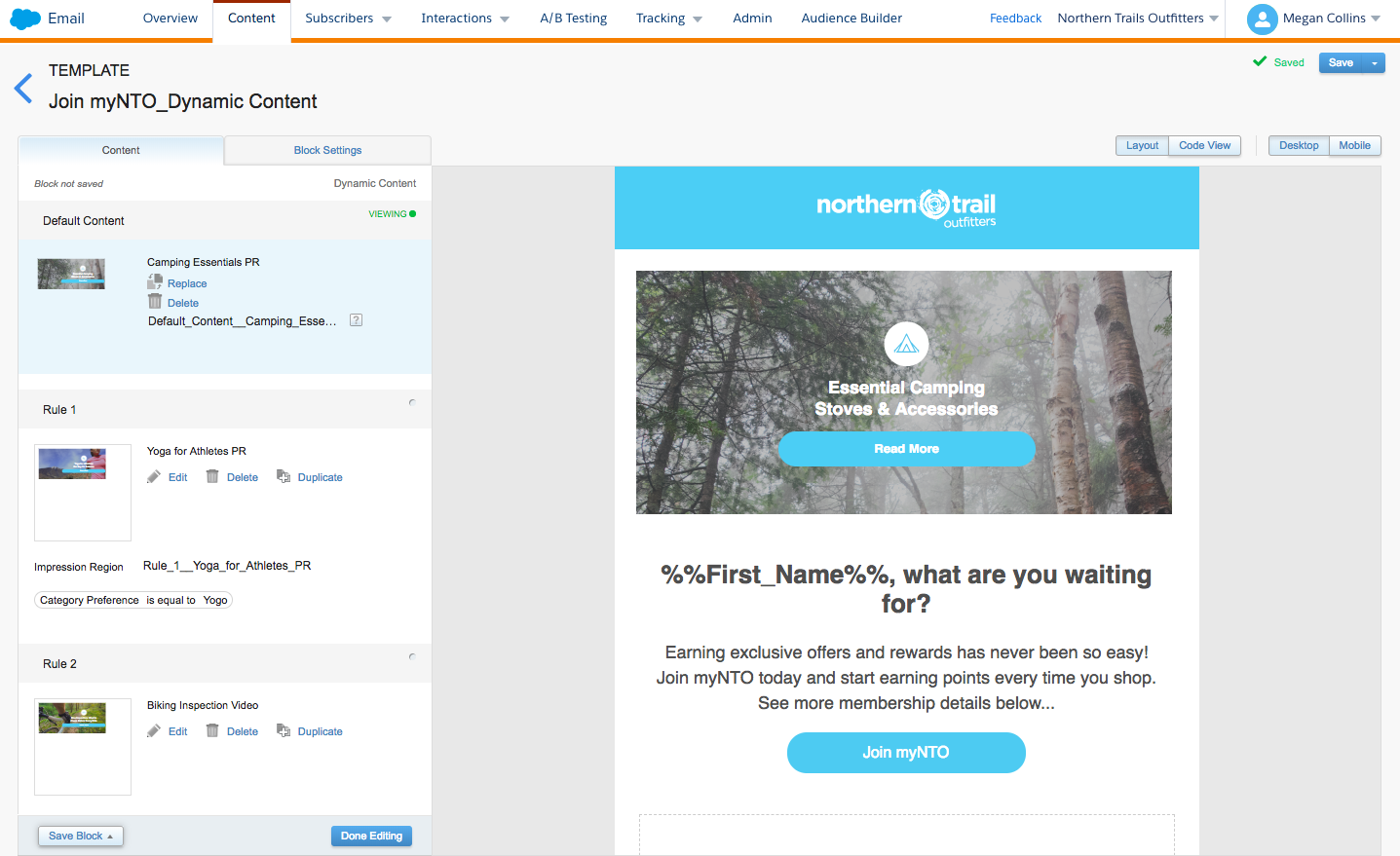
Considerations for Creating Effective Emails
Begin with the first experience: What do your customers see while they are scrolling through their inbox? Inboxes are saturated, and making your email stand out is important. This initial experience considers the sender name, subject line, and preheader text.
|
Sender name |
The sender name tells viewers who sent the email. This is most likely the name of your company or brand. |
|
Subject line |
The subject line tells subscribers what your email is about. The most effective subject lines reflect the content in the email and encourage engagement. |
|
Preheader text |
Preheader text is customizable content between 35 and 140 characters that appears next to or below the subject line in email inboxes. |
Yes! You got everyone to open your email. But open rates aren’t the only thing you are concerned about. You want customers to engage.
Next, focus on the preview: Why are you sending this email? Why should subscribers read more? For this, you need to focus on your preview, header, and navigation bar.
|
Preview |
The preview view is the first version of the actual HTML email that typically does not include images or interactive content. |
|
Header |
The header is at the top of your email. Make sure it includes your logo. |
|
Navigation bar |
The navigation bar mimics your website navigation and includes links to major entry points for your site. |
Now think about your goals for this email. What action do you want viewers to take? Put that front and center, and make it exciting and fun. But keep it short and sweet, because viewers don’t spend more than a few seconds reading an email. Here you’ll leverage the primary message, social media bar, and footer.
|
Primary message |
The primary message is your main reason for sending the email. Make sure it includes a clear call to action. |
|
Social media bar |
Here you include links to your brand’s pages on social media. |
|
Footer |
This is the “fine print,” including an unsubscribe link, compliance information, and disclaimers. |
Now that you’ve seen a breakdown of pieces to consider, let’s see an example. Let’s say your customer was browsing your website and abandons their cart. This is the perfect chance to send relevant content to your customer including a reminder to make the purchase. To take that a step further, you can utilize the insight you have about your customer and provide recommendations based on their behavior.
- What is the first thing you want your customers to see to entice them to open the message? Include an image of something they may have put in their cart.
- What can you include in the body to drive click-through rates? Provide a clear call to action to complete the purchase.
- How do you conclude the email to ensure you are keeping your brand top of mind? Recommendations provide a great way to keep your customer engaged.
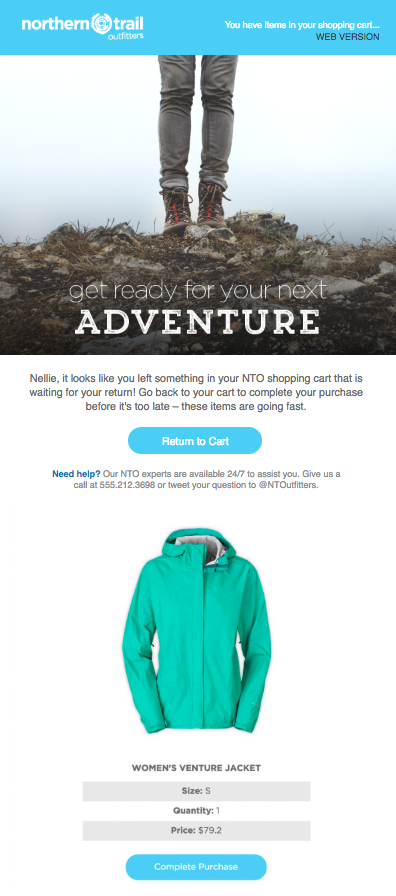
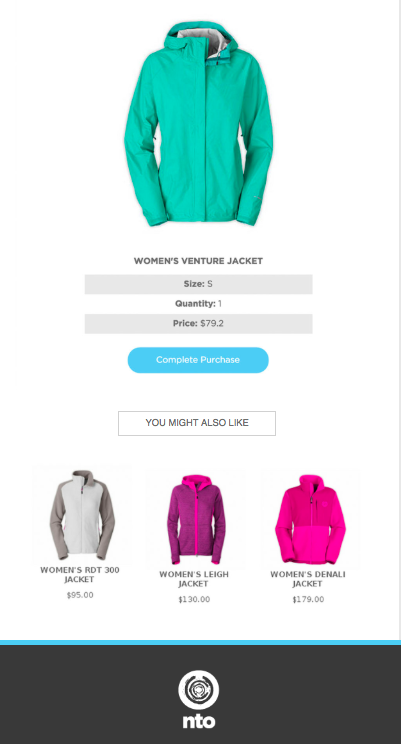
Design Considerations
Finally, optimize your emails with responsive design. More than half of consumers open their email from a mobile device (Litmus). So, keeping your emails concise can help you increase engagement. Ideally, create fluid, scalable, adaptive, responsive designs powered by live content. If you have some technical support, you can also use CSS3 media queries in the email to detect screen size. Then, styles are overwritten to adjust text size, frame width, and image size for a more usable experience.
How do you keep it simple but still get your message across? Use a single-column format for images and copy. Two-column grids sometimes look nice, but they may not render as well. Use large text and buttons with plenty of space around them.
Set Image Properties
Limit large images and graphics by specifying height and width. Use ALT tags (alternative text) to let your subscribers know what the image is if it doesn’t appear. This is important when it comes to image blockers, which may block your content on certain sites.
Focus on Mobile
When you follow mobile-first email design, tailor interactive content and calls to action for multiple screen sizes. Mobile users must be able to read and navigate comfortably.
Test and Optimize Email Performance
We talked earlier about understanding your customers. You’ve identified their needs and probable questions. Now use your data to test how they respond to personalized content. You can start to collect and analyze data about your subscribers, your send results, and your tests to enhance your email content strategy.
What kinds of data can you look at?
|
Demographic data |
A subscriber’s name, mailing address, gender, age, birth date, and other information the subscriber shared on a signup form. |
|
Behavioral data |
Data from tracking actions across multiple channels, including purchase history, downloads, browsing activity, and email opens, usually accessible in your CRM or analytics platform. |
|
Contextual data |
Delivers information about the moment a subscriber opens an email, including device, location, date, time, or weather. |
As you track this customer data, the positive statistics are likely to stand out: increased deliverability and opens, increased clicks and conversions. But watch for negative metrics, too. Unsubscribe rates, soft bounce rates, and hard bounce rates can help you understand what’s not working.
Who should you watch out for specifically? New customers are an ideal testing group. You have not yet influenced them with your marketing efforts, so tracking them is an easy way to test your new content strategy.
Introducing Content Builder and Email Studio
You’re ready to execute your email content strategy. Let’s look at the tools to get you started. Salesforce Marketing Cloud Engagement has the one-two punch when it comes to creating content and delivering contextual emails at scale: Content Builder and Email Studio.
Content Builder
Content Builder is changing the way marketers create and manage content. With this cross-channel content management tool, you can consolidate images, content blocks or areas, templates and emails in a single location for use in Marketing Cloud Engagement. That means you spend less time creating and finding the perfect content and more time putting it into action.
Email Studio
Email Studio is the leading enterprise email marketing platform. It lets you create intelligent, personalized emails at scale—all without needing to code. It is your vehicle for bringing your content to life. You can see more about these tools in the video. See the Email Studio Basics module to learn more about working with Email Studio. Learn more with Content Builder Basics.
Content continues to be a powerful tool to reach a massive audience and connect in a personal way. You can create compelling content by understanding your customer personas. Then use dynamic content to segment your audience and recommendations to drive personalization engagements. You can do this with Content Builder and Email Studio, to learn more check out the next badge for Content Builder Basics.